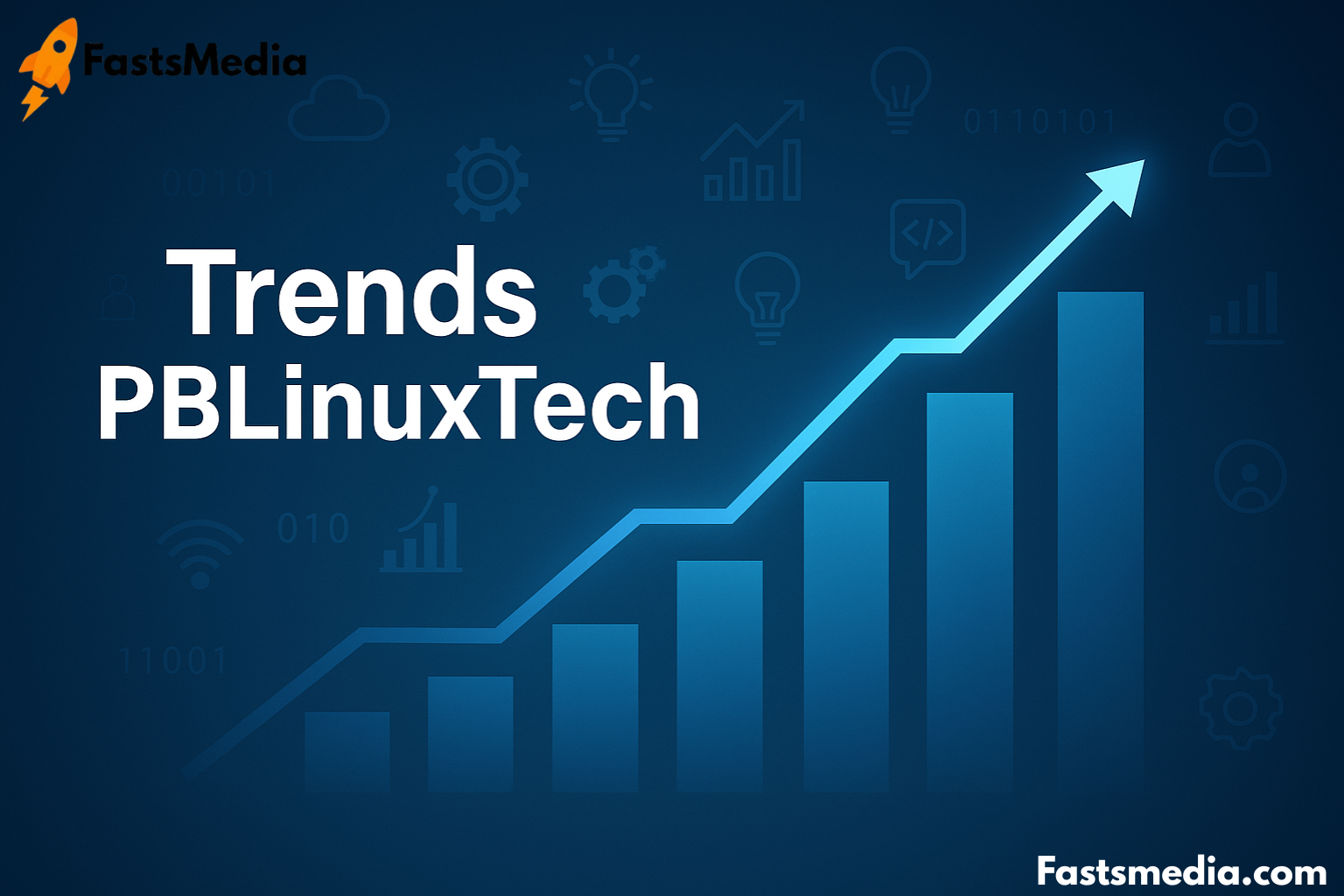Introduction
The world of open-source technology is evolving faster than ever, and Trends PBLinuxTech stands at the forefront of this transformation. Representing the growing intersection of Linux, performance optimization, cybersecurity, and modern computing, PBLinuxTech highlights how open-source systems continue to power everything from enterprise servers to personal gaming setups.
In recent years, Linux-based technologies have expanded their influence across cloud computing, DevOps automation, cybersecurity, and artificial intelligence. The trends emerging in this field — such as containerization, automation, system hardening, and Linux gaming — are redefining the possibilities of open systems. Whether you are a developer, a system administrator, or simply a tech enthusiast, understanding these PBLinuxTech trends helps you stay ahead in a rapidly changing digital landscape.
The Rise of Containerization and Virtualization
Understanding Containerization in Modern Linux
Containerization has become one of the most transformative elements in the Linux ecosystem. Using tools like Docker, Podman, and Kubernetes, developers can now run applications in isolated environments that ensure efficiency, scalability, and portability.
Unlike traditional virtualization, which emulates entire operating systems, containers use shared kernels to minimize resource consumption while maintaining stability. This approach has enabled enterprises to deploy complex microservice architectures that are more modular and easier to manage.
Benefits and Real-World Impact
Containerization offers significant benefits such as reduced deployment times, simplified updates, and improved collaboration between development and operations teams (DevOps). As a result, PBLinuxTech continues to push for container-native systems that emphasize agility and fault tolerance in production environments.
Automation and Infrastructure as Code (IaC)
Why Automation is the Core of Modern Linux Systems
In the realm of PBLinuxTech, automation is not a luxury — it’s a necessity. The shift towards Infrastructure as Code (IaC) allows organizations to define, manage, and deploy their infrastructure through machine-readable configuration files rather than manual processes.
Step-by-Step: Implementing IaC with Linux Tools
- Define the Infrastructure: Use tools like Terraform or Ansible to describe servers, networks, and configurations in code format.
- Version Control: Store your configuration files in Git or similar systems for better collaboration and rollback capability.
- Automate Deployment: Apply automation scripts to deploy and configure systems consistently.
- Monitor and Update: Continuously monitor performance using tools such as Prometheus or Grafana.
- Refine Over Time: Adjust configurations based on system feedback and performance data.
This method ensures consistency, scalability, and traceability — values at the heart of PBLinuxTech’s innovation philosophy.
Enhanced Security and System Hardening
The Growing Importance of Cybersecurity in Linux Systems
As cyber threats evolve, security hardening has become one of the most critical trends in PBLinuxTech. Linux distributions now come equipped with advanced security modules such as SELinux, AppArmor, and Firejail, designed to isolate processes and minimize vulnerabilities.
The open-source nature of Linux also means that vulnerabilities are often discovered and patched quickly by the community. This collaborative approach makes Linux inherently more transparent and secure compared to closed-source systems.
Actionable Tips for Strengthening Linux Security
- Update Regularly: Always keep your kernel and packages up to date.
- Use Role-Based Access Control (RBAC): Limit user permissions to the minimum necessary.
- Implement Firewalls: Tools like UFW or iptables can control traffic effectively.
- Encrypt Data: Use LUKS or VeraCrypt for data-at-rest encryption.
- Audit Logs: Regularly review system logs for unusual activity using
journalctlorauditd.
By following these steps, PBLinuxTech systems maintain integrity, confidentiality, and availability — the three pillars of cybersecurity.
Linux Gaming: A Rising Trend
From Servers to Steam Decks — The Gaming Revolution
For decades, Linux was seen primarily as a developer’s or server administrator’s operating system. However, the Linux gaming landscape has dramatically changed thanks to technologies like Proton, Wine, and Vulkan. Platforms such as SteamOS (powered by Linux) and the Steam Deck have proven that Linux can deliver a powerful and stable gaming experience.
Optimization and Community Support
The Linux gaming community — a crucial part of the PBLinuxTech ecosystem — actively contributes to improving driver compatibility, reducing latency, and optimizing performance. Users can now enjoy AAA titles on Linux systems with near-native performance, all while benefiting from open-source flexibility and security.
As this trend continues, gaming under Linux could become one of the defining success stories of PBLinuxTech’s broader open-source mission.
Open Source Collaboration and Future Innovation
Community-Driven Development
At its core, PBLinuxTech thrives on community collaboration. Developers worldwide contribute to improving kernels, libraries, and applications, ensuring rapid innovation and problem-solving. Open forums, Git repositories, and Linux Foundation initiatives foster a global exchange of ideas that strengthens the ecosystem.
The Future: AI, Cloud, and Edge Computing
The next generation of PBLinuxTech trends will likely involve artificial intelligence (AI) and edge computing. Linux systems are already at the heart of cloud infrastructure, and with the rise of IoT (Internet of Things), the need for lightweight, secure, and adaptive systems will only grow. PBLinuxTech aims to continue bridging traditional computing with new frontiers of machine learning and distributed networks.
Conclusion
The evolution of Trends PBLinuxTech reflects a broader movement toward open innovation, efficiency, and adaptability in modern computing. From containerization and automation to gaming and cybersecurity, these developments showcase Linux’s unparalleled flexibility and resilience.
As businesses, developers, and individuals continue to adopt open-source technologies, the influence of PBLinuxTech will expand even further — shaping the future of digital infrastructure, cloud platforms, and personal computing.
Whether you’re deploying enterprise systems or customizing your Linux desktop, understanding these trends helps you unlock the full potential of the world’s most versatile operating system.
FAQs
Q1. What does PBLinuxTech stand for?
PBLinuxTech represents a convergence of modern Linux technologies focusing on performance, security, automation, and open-source innovation.
Q2. Why is containerization important in PBLinuxTech?
Containerization allows developers to isolate and deploy applications efficiently, reducing conflicts and improving scalability in production environments.
Q3. How does PBLinuxTech improve Linux security?
Through built-in hardening tools like SELinux and AppArmor, frequent updates, and active community monitoring, PBLinuxTech ensures strong protection against cyber threats.
Q4. Can Linux really compete with Windows for gaming?
Yes. With Proton, SteamOS, and Vulkan drivers, Linux now supports most major games with excellent performance and community-driven optimization.
Q5. What’s next for PBLinuxTech?
Future trends include deeper AI integration, automation through Infrastructure as Code, and greater focus on lightweight systems for cloud and edge computing.

